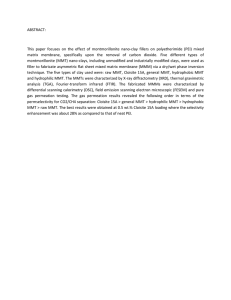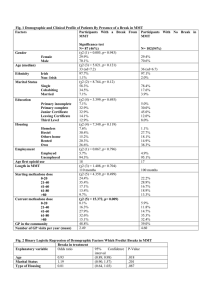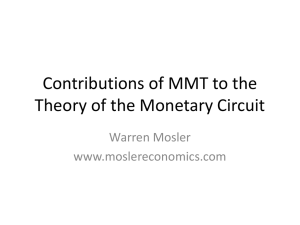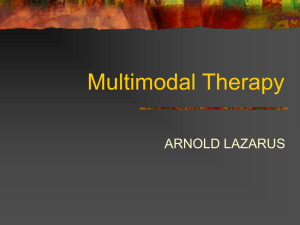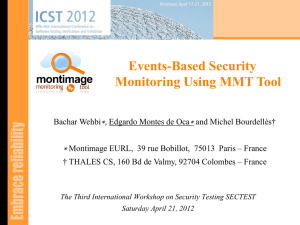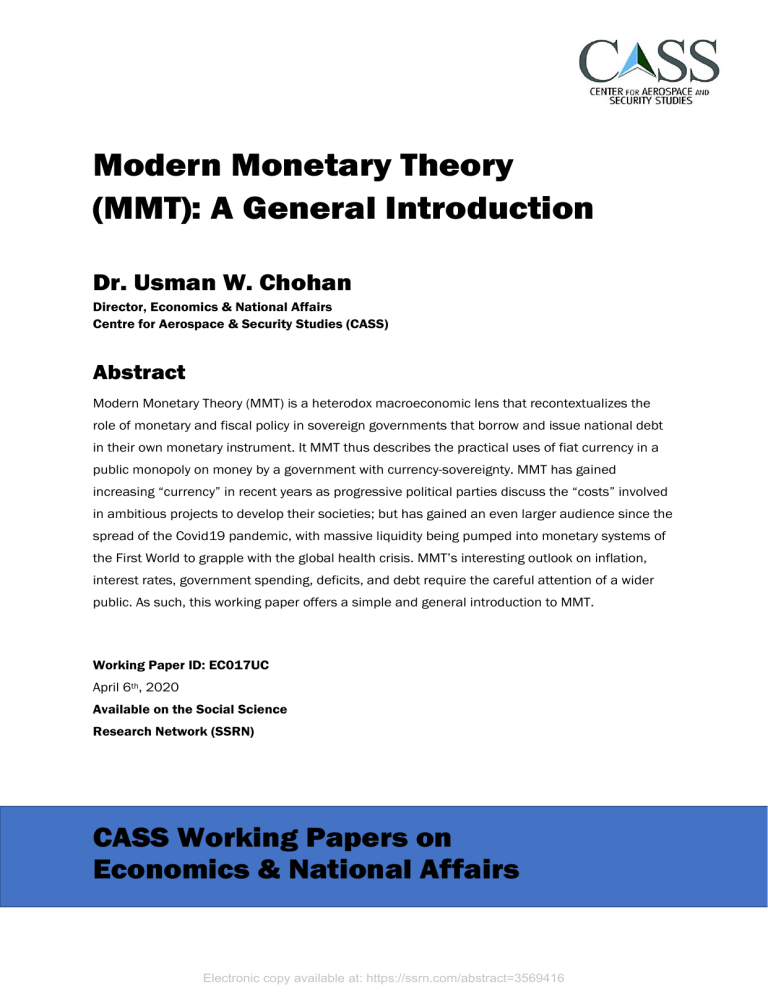
Modern Monetary Theory (MMT): A General Introduction Dr. Usman W. Chohan Director, Economics & National Affairs Centre for Aerospace & Security Studies (CASS) Abstract Modern Monetary Theory (MMT) is a heterodox macroeconomic lens that recontextualizes the role of monetary and fiscal policy in sovereign governments that borrow and issue national debt in their own monetary instrument. It MMT thus describes the practical uses of fiat currency in a public monopoly on money by a government with currency-sovereignty. MMT has gained increasing “currency” in recent years as progressive political parties discuss the “costs” involved in ambitious projects to develop their societies; but has gained an even larger audience since the spread of the Covid19 pandemic, with massive liquidity being pumped into monetary systems of the First World to grapple with the global health crisis. MMT’s interesting outlook on inflation, interest rates, government spending, deficits, and debt require the careful attention of a wider public. As such, this working paper offers a simple and general introduction to MMT. Working Paper ID: EC017UC April 6th, 2020 Available on the Social Science Research Network (SSRN) CASS Working Papers on Economics & National Affairs Electronic copy available at: https://ssrn.com/abstract=3569416 Table of Contents Introduction ............................................................................................................................................3 The Precepts of MMT .............................................................................................................................5 Criticism of MMT ................................................................................................................................. 10 Implications of MMT and the Road Ahead ........................................................................................ 13 References .......................................................................................................................................... 18 Author’s note: MMT constitutes a complex set of discussions with a shared ethos and certain common features: an accounting identity, a neo-chartalist view of money & credit, a view on monetary operations, and certain policy recommendations. Given the diversity of details in the various viewpoints that together comprise MMT, this working paper can only hope to do partial justice to the field. This is all the more true given the continually evolving nature of MMT’s debates, and their increasing interest in policy circles in the First World. Yet covering the rigor of the MMT domain more fully would require much more room than would be permissible in the pages of a working paper. For this reason, suggested readings are mentioned in the introductory section. It is also worth mentioning that I am neither a proponent nor opponent of MMT, but I do see value in discussing its arguments in both a post-2008 GFC crisis context as well as a Covid19 context. Electronic copy available at: https://ssrn.com/abstract=3569416 Introduction Modern Monetary Theory (MMT) is a macroeconomic lens that recontextualizes the role of fiscal policy and its supposed constraints through the calculus of money issued by sovereign governments that borrow and issue national debt in their own currency. MMT thus describes the practical uses of fiat currency in a public monopoly on money by a sovereign monetary authority, and is based on the notion of functional finance,1 in that governments should set whatever fiscal positions are consistent with price stability and full employment, irrespective of debt/deficit levels. As such, there is no financial constraint on fiscal policy in MMT. Its adherents apply an interesting aphorism that, “to understand MMT, understand why the banker in Monopoly [board game] can never run out of money,”2 (Mitchell et al., 2019). MMT has gained increasing “currency” in recent years as progressive political parties discuss the “costs” involved in ambitious projects to develop their societies, such as the Green New Deal (GND) proposed by US Democrats.3 Yet MMT has gained an even larger audience since the spread of the Covid19 pandemic, with massive liquidity being pumped into monetary systems of the First World to grapple with the global health crisis. MMT’s interesting outlook on inflation, money supply, deficits, and debt require the careful attention of a wider public. As such, this working paper offers a simple and general introduction to MMT. Its structure is as follows: the remainder of this introductory section will highlight some important texts for scholars to consider in informing their enquiry in fuller detail. The next section, lying at the crux of this working paper, is a discussion of the precepts of MMT in a deliberately simplified language. The following section will discuss some criticisms of MMT, particularly from orthodox high-priests of economics. Thereafter, certain implications of MMT are discussed, not just where they are applicable (in strong sovereign currency-issuing monetary authorities), but also where they are not (the developing world or dependent and less-sovereign authorities). This will lead to the starkest claim regarding MMT: that it is a theory of empire. A final section examines MMT going forward, anticipating a very wide appeal of MMT in policy circles and political-economy decisionmaking bodies in the next few decades, noting the natural spark that the pandemic of Covid19 has triggered, but which shall last in the years to come. 1 See original formulation in Lerner, A. P. (1943), ‘Functional finance and the federal debt’,Social research. 38–51. 22 3 Mitchell, W., Wray, L.R., and Watts, M. (2019). Macroeconomics. Red Globe Press. See literature review of GND in Chohan, Usman W., A Green New Deal: Discursive Review and Appraisal (2019). Notes on the 21st Century (CBRI), Electronic copy available at: https://ssrn.com/abstract=3569416 The most useful textbook analysis of MMT is the recent work of Mitchell, Wray and Watts,4 which provides a rich and multifaceted explanation of the major sub-debates within MMT and how they may be synthesized towards the larger theory of MMT. An earlier tome which considered the importance of going past the Keynesian-Monetarist dichotomy after the abolition of the Gold Standard is Visser’s 1991 textbook, although the hindsight of the past thirty years does much to corroborate his discussion on inflation and the money supply.5 For a general introduction, it is also particularly useful to consider the summation of MMT by Ehnts,6 in particular because it structures the discussion of MMT in a sequentially-logical manner. It begins with the question the substance and purposes of economic activity before discussing the constituent parts of money and credit, including sequentially: debt and balance sheets, the creation of bank deposits, the instruments of a central bank, the creation of sovereign securities, the sustainability of the financial system, and inflation/deflation. It then offers a macroeconomic model focused on the eurozone. There are also useful works that situate MMT’s concepts in the work and lexicon of earlier thinkers and schools of thought. Tsiang’s work is important in situating the MMT approach in the lexicon of monetarists,7 while Nesiba’s is important in comparing MMT with post-Keynesian thought.8 Alvarez and Bignon explain MMT in terms of the contrast between Leon Walras and Menger, which helps ground the question of the origin of modern money in existing debates.9 Cesarano situates the enlightenment philosopher David Hume’s ideas in MMT.10 In terms of the policy proposal implications by the US Democratic party, Stephanie Kelton (née Bell), who is also an economic adviser to Sen. Bernie Sanders, provides interesting MMT perspectives vis-à-vis 4 Mitchell, W., Wray, L.R., and Watts, M. (2019). Macroeconomics. Red Globe Press. 5 Visser, H., (1991). "Modern Monetary Theory," Books, Edward Elgar Publishing, number 457. 6 Ehnts, D. H. (2016). Modern monetary theory and European macroeconomics. Taylor & Francis. 7 Tsiang, S. C. (1989). The monetary theoretic foundation of the modern monetary approach to the balance of payments. In Finance Constraints and the Theory of Money (pp. 153-175). Academic Press. 8 Nesiba, R. F. (2013). Do Institutionalists and post-Keynesians share a common approach to Modern Monetary Theory (MMT)?. European Journal of Economics and Economic Policies: Intervention, 10(1), 4460. 9 Álvarez, A., & Bignon, V. (2013). L. Walras and C. Menger: Two ways on the path of modern monetary theory. The European Journal of the History of Economic Thought, 20(1), 89-124. 10 Cesarano, F. (1998). Hume's specie-flow mechanism and classical monetary theory: An alternative interpretation. Journal of International Economics, 45(1), 173-186. Electronic copy available at: https://ssrn.com/abstract=3569416 deficits, spending, and money supply.1112 Kurihara also provides useful commentary on public policy implications.13 These readings supplement the general discussion presented in the following sections. The Precepts of MMT MMT scholarship (as enumerated above), tends to have several moving parts to the discourse, and its explanations often offer: (1) a theory of money (a form of chartalism),14 (2) a discussion of monetary operations as they are performed today,15 (3) a discussion of the mechanics behind national income accounting, (4) certain public policy or political programs (e.g. a job guarantee)16, and oftentimes a practitioner program for implementing macroeconomic agendas. As Taylor puts it, the three “foundation myths” of MMT are: “the Chartalist view of money, functional finance with attention to business cycles, and consistent macroeconomic accounting.”17 MMT’s preponderant view is one of functional finance, in that “governments should set their fiscal position at whatever level is consistent with price stability and full employment, regardless of current debt or deficits.”18 There is therefore no financial constraint 11 Kelton, S. (2020). The deficit myth: modern monetary theory and the birth of the people's economy. PublicAffairs. 12 See also Fullwiler, Scott T. and Bell, Stephanie A. and Wray, L. Randall, Modern Money Theory: A Response to Critics (January 15, 2012). Available at SSRN: https://ssrn.com/abstract=2008542 or http://dx.doi.org/10.2139/ssrn.2008542 13 Kurihara, K. K. (2013). Monetary theory and public policy. Routledge. 14 MMT is often described as “neo-chartalist” in that it speaks to the chartalist theory of the development of money. Chatalism proposes that states created money as a means of directing economic activity or paying for activities required as part of state-building (particularly militarily). This contrasts with the mythic concepts that have abounded in economics historically about “barter” as the origin of money. This myth has effectively been demolished by the anthropological literature, most notably in David Graeber’s magisterial work, Debt: the First 5000 Years. See Graeber, D. (2012). Debt: The first 5000 years. Penguin UK. 15 Monetary operations as exercised by the central bank specifically but by government more generally in some instances. 16 The notion of a job guarantee aims to mitigate the unemployment problem by guaranteeing work to citizens. It is a manifestation of the fundamental right to work as enshrined by the United Nations Universal Declaration of Human Rights, Article 23 (1). 17 Taylor, L. (2019). Synthetic MMT: Old Line Keynesianism with an Expansionary Twist. Institute for New Economic Thinking Working Paper Series, (103). 18 Jayadev, A., & Mason, J. W. (2018). Mainstream Macroeconomics and Modern Monetary Theory: What Really Divides Them?. Institute for New Economic Thinking, 6. Electronic copy available at: https://ssrn.com/abstract=3569416 on fiscal policy, and it should be pursued (towards the best goals) up and until price stability / full employment is attained, without any obsession with the level of debt or deficits being incurred. To build its arguments, MMT begins with the concept of the monopoly power over currency issuance. As the state is the sole legal supplier of a sovereign currency, noting therein that money today is not even paper money but rather a set of digits in safely-guarded spreadsheets, and that money is largely “credit” created rather than cash delivered; the sovereign has monopoly power over the instrument and can issue as much of it as it likes. It has the monopoly over a legitimized but abstract object of ascribed value, which society can and must use to transact. It can then pay for its debts denominated in that currency by simply issuing more of it. After all, in the post-gold standard era, what is the value of its money tied to but itself? Herein lies the legacy of removing the gold standard, to which currencies used to be pegged and made convertible along a determined ratio. MMT argues that the world has yet to come to terms with the demise of that system, abolished by US President Richard Nixon in 1971, In essence, the U.S. and other major sovereign currency issuers no longer need to fear a shortage of gold to back their money, leaving them free to issue as much as desired.19 MMT’s assessment on the creation of money through the banking system is important to understand in that regard. In contrast to conventional interpretations, banks do not issue loans out of deposits; but rather issue loans based on the demand for borrowing. Those who borrow from banks then stash their proceeds in the bank. Whomsoever receives a check simply makes another deposit in a bank. As such, MMT views the causality in reverse: deposits do not create loans; loans create deposits.20 This is one aspect of MMT that even some conservative central bankers—including those at Germany’s Bundesbank—agree with. From a historical perspective (see review in introductory section as well), MMT’s proponents advocate that their vision is the truest, most legitimate heir to Keynes and his paradox of thrift,21 which had (according to them) been hijacked after Keynes’ demise by excessively mechanistic model-makers in economics such as Nobel Prize winner Paul Samuelson,22 who harbored the 19 A useful history of the 20th century economy in light of the gold standard, the euro, and neo-imperialism is found in the works of Varoufakis, most notably: Varoufakis, Y. (2015). The global minotaur: America, Europe and the future of the global economy. Zed Books Ltd.. 20 Even conservative central bankers such as the German Bundesbank openly agree with this interpretation. 21 See useful review in Bryant, J. (1987). The paradox of thrift, liquidity preference and animal spirits. Econometrica: Journal of the Econometric Society, 1231-1235. 22 Samuelson, P. A. (1966). The collected scientific papers of Paul A. Samuelson (Vol. 2). MIT press. Electronic copy available at: https://ssrn.com/abstract=3569416 illusions of transmuting the social science into a physical or natural science.23 In particular, these illusions were destructive for the discipline because they suppressed the nebulous realities and the role of fundamental uncertainty.24 Samuelson’s breed of model-fixated traditionalists were disparaged as the “bastard Keynesianism,” by late British economist Joan Robinson.25 Instead, MMT draws upon Lerner’s concept of functional finance, as mentioned earlier, which stipulated that governments ought to spend whatever is required to achieve the government’s goals, without fear of deficits.26 It also draws upon British macroeconomist Wynne Godley’s concept of sectoral balances, which draws attention to the accounting relationship between the government and non-government sector.27 According to his work, there is a balance in the sense that, whenever the government runs a deficit, the remaining nongovernment sector must run a surplus (and vice versa). By that account, running deficits shouldn’t be seen to impede government programs that develop society, since the surplus of that expenditure will be felt in the nongovernmental sector.28 In addition, MMT’s proponents articulate an important counterpoint to the monetarist school, which seeks to highlight the role of independent central bank monetary operations. The argue instead that there is a natural rate of interest in a world of fiat money, which is zero. Furthermore, anything higher than that is a bonus to the investor class. This has important implications for the praxis of modern central banks which find near-zero interest rates, and in fact negative real interest rates in some countries. As Taylor observes, this reflects the fact that traditional models “don’t fit today’s institutions or data.”29 Many recent papers from central banks echo this realization that the natural rate of interest might be zero or lower due to larger considerations, such as “demographics and growth, but also the recent financial crisis with weak aggregate demand, deleveraging, etc., are identified as factors related to this decline.”30 23 See arguments in Eichner, A. S. (1983). Why Economics is not yet a Science. Journal of Economic Issues, 17(2), 507-520. 24 Dequech, D. (2000). Fundamental uncertainty and ambiguity. Eastern Economic Journal, 26(1), 41-60. 25 Robinson, J. (1967). Essay on Marxian Economics. Springer. 26 1. 27 Godley, W., & Lavoie, M. (2006). Monetary economics: an integrated approach to credit, money, income, Lerner, A. P. (1943), ‘Functional finance and the federal debt’,Social research pp. 38–51. production and wealth. Springer. 28 Blackbaby, F. T. (2011). Wynne Godley–A Bibliography. The Stock-Flow Consistent Approach: Selected Writings of Wynne Godley, 255. 29 Taylor, L. (2017). The “Natural” Interest Rate and Secular Stagnation: Loanable Funds Macro Models Don't Fit Today’s Institutions or Data. Challenge, 60(1), 27-39. 30 Galesi, A., Nuño, G., & Thomas, C. (2017). The natural interest rate: concept, determinants and implications for monetary policy. Banco de Espana Article, 7, 17. Electronic copy available at: https://ssrn.com/abstract=3569416 On the point of interest rates, MMT further challenges a core belief among the high-priests of conventional economics, that an increase in budget deficits will tend to raise interest rates ceteris paribus.31 This belief has been a pillar in the dissuasion of running large government deficits.32 What MMT asserts, by contrast, is that when government spending rises, the private sector receives the money and puts it in the banking system. Ergo, when deficits rise from government spending and private sector receives the stimulus, its storage in the banking system will increase its stock without any additional increase in demand for the money deposited, which will in fact lead interest rates to fall. Beyond this, for MMT theorists, the adjustments of interest rates are not effective because of the logic of businesses, which make investment decisions based on prospects for growth, not the cost of money.33 Throwing cheaper money at businesses will not induce them to invest as much as a more positive appraisal of their forward-looking growth prospects would. This has been amply demonstrated in the inter-crisis period (2009-19), where much of the near-zero interest rate Fed stimulus was an injection of money into the system, but an intolerably large proportion of this was used by corporations for stock buybacks.34 Stock buybacks are a logical consequence of too much capital available to firms in relation to their future growth potential; and if they do not see avenues for investing to grow, they will instead use the capital to repurchase their stock.35 In certain industries decimated by the Covid19 pandemic, such as the airlines industry, this large squandering of capital in buybacks as opposed to investing in R&D or a newer fleet reflects that assertion. Yet the airlines industry, as of this writing, is going hat-in-hand to Washington for another industry bailout. Although MMT is a “monetary” theory, its emphasis is on driving economic development through fiscal policy.36 As Mitchell et al state, modern governments “tend to run unduly restrictive fiscal 31 Evans, P. (1987). Interest rates and expected future budget deficits in the United States. Journal of political Economy, 95(1), 34-58. 32 Blanchard, O. J. (1984). Current and anticipated deficits, interest rates and economic activity. European Economic Review, 25(1), 7-27. 33 Taylor, L. (2019). Synthetic MMT: Old Line Keynesianism with an Expansionary Twist. Institute for New Economic Thinking Working Paper Series, (103). 34 See Chohan, U.W. (2020c). A Post-Coronavirus World: 7 Points of Discussion for a New Political Economy. CASS Working Papers on Economics & National Affairs No. EC015UC. 35 While this is the logical interpretation, the elephant in the room of sheer greed, which is not something economic models grapple with very well, also has an important explanatory factor given that executive bonuses are tied to stock price increases. 36 i.e. through government spending and taxation. Electronic copy available at: https://ssrn.com/abstract=3569416 policy stances so as not to contradict the monetary policy stance.”37 Central bank independence (CBI), which is a staunch tenet of orthodox economics because of the fear of runaway inflation in a political budget cycle,38 does not cohere with MMT since the central bank is assumed to print (i.e. put into its spreadsheet) what treasury asks it to print. Taxation is not intended as a source of government revenue in MMT, rather it is the source of demand for the money that the sovereign issues. In other words, since the US government will only accept US dollars as the medium to pay taxes, businesses and citizens must have US dollars in order to pay those taxes. This is a money demand-creation aspect of taxation that MMT highlights. At the same time, taxation can be a tool for redistribution of wealth, which furthers other societal objectives and leads to more broad-based demand, but it still doesn’t represent a “revenue source” for governments, who can simply issue currency and have all the “revenue” they require.39 Taxes should thus withdraw just a sufficient amount from citizens and businesses such that total spending in the macroeconomy does not become excessive. MMT argues that governments do not need to pay excessive heed to debt/deficit levels, and therefore to sell treasury securities or levy taxes, since a central bank under the control of the treasury can conjure the electronic money required to cover all requirements. MMT exhibits a strong penchant for the concept of “automatic stabilizers” that would have counter-cyclical impacts at different stages of the business cycle. Their strongest advocacy is for the job guarantee system mentioned earlier, which would employ more people in economic downturns than in upturns.40 In the US context, many MMT proponents suggest that the job guarantee system be federally-funded and locally-administered. Representative Alexandria Ocasio-Cortez, the Democratic Socialist from New York, and one of the key political figures paying heed to MMT in Congress, supports the job guarantee and says MMT should be “a larger part of our conversation.”41 Noting that there are two forms of inflation (demand-pull and cost-push), advocates of MMT assert that inflation in not the result of excessive economic growth (i.e. demand-pull). Instead, MMT’s advocates draw attention to a more conflictual reality in modern capitalist societies: the excessive pricing power of businesses, which are monopolistic and extract supernormal profits that generate macro-level inflation. The remedy for this, according to 37 Mitchell, W., Wray, L.R., and Watts, M. (2019). Macroeconomics. Red Globe Press. 38 See Chapter 4 on CBI in Chohan, U.W. (2020). Reimagining Public Managers: Delivering Public Value. Routledge. 39 Wray, L. R. (1998). Understanding modern money (Vol. 11). Cheltenham: Edward Elgar. 40 During the Covid19 pandemic, a similar (but not identical) issue of maintaining payrolls even when people could not or did not work was raised as a stabilizer for the stalling economic activity. 41 Goldstein, S. (2018). Jobs-guarantee idea gets new focus after Ocasio-Cortez victory. Market Watch. June 27. Electronic copy available at: https://ssrn.com/abstract=3569416 MMT theorists, is to go after monopolies and to stop banks from issuing too many loans, rather than cut growth. Under MMT, the fiscal expertise of governments, including Legislative Budget Offices (LBO),42 should not be channeled towards “costing” what policies will be in terms of the debt/deficit impact, but rather to ask these institutions what the impact will be on full employment and price stability going forward. Although there are indeed other concepts subsumed within MMT, these differ among theorists to some degree. Covering each of the remaining elements is beyond the scope of this working paper, but it is helpful to consider the works cited in the introductory section of this paper to delve further into those intricacies, as required. The following section considers some of the primary criticisms lodged against MMT by its mainstream detractors. Criticism of MMT Criticisms of MMT are vociferously articulated by stalwarts of the academy. For example, Kenneth Rogoff has described the theory as “Modern Monetary Nonsense,”43 but Galbraith corrects some misconceptions presented by Rogoff as part of the same debate.44 Palley summarizes his critique of MMT thus: “MMT over-simplifies the challenges of attaining non-inflationary full employment by ignoring dilemmas posed by the Phillips curve, maintaining real and financial sector stability, and an open economy. Its policy recommendations take little account of political economy difficulties, while its interest rate policy recommendation would likely generate instability.”45 What is important to recognize here is the limitations of the Philips curve for a long-term deflationary rich country, where inflation isn’t being generated no matter how much money is put in as stimulus,46 which is why the Philips curve may be “broken for good”.47 Some observers note that there is a surprising amount of vitriol hurled against MMT even by economists whose general thesis is in accord with MMT. For example, the mainstream brahmin of economics, Larry Summers, has long argued that the first world has entered a phase of 42 See Chohan, U.W. (2018c). The Roles of Independent Legislative Fiscal Institutions: A Multidisciplinary Analysis. UNSW, Canberra, Australia. 43 Rogoff, K. (2019). Modern monetary nonsense. Project syndicate, 4(03). 44 Galbraith, J. (2019). Modern Monetary Realism. Project Syndicate, March, 15. 45 Palley, T. I. (2015). Money, fiscal policy, and interest rates: A critique of Modern Monetary Theory. Review of Political Economy, 27(1), 1-23. 46 Goutsmedt, A. (2019). James Forder, Macroeconomics and the Phillips Curve Myth. Œconomia. History, Methodology, Philosophy, (9-3), 589-594. 47 The Economist .(2017). The Phillips curve may be broken for good. November 1. Electronic copy available at: https://ssrn.com/abstract=3569416 “secular stagnation,”48 which requires high-levels of stimulus spending and the incurring of deficits to keep these aging economies from a long-term recession.49 This is precisely the argument of MMT, as discussed in the section above. Some political economy critiques of MMT involve the responses of governments to crises. First, they question whether the legislature and executive branches can act quickly enough to respond to an economic downturn. This is debatable, because the 2008-09 crises demonstrated strong government and central bank resolve to stimulate the economy somewhat quickly, although expecting a knee-jerk reaction may be unrealistic. Hence, there is strong MMT advocacy of automatic stabilizers such as a jobs guarantee program. Second, they argue that politicians are weary of imposing hardship on the public through contractionary fiscal policy50 to curb runaway inflation. This is also a contested criticism, and MMT’s general response is one of automatic stabilizers acting instead of a reliance on politicians to make unpalatable political decisions. On that front, the tool of automatic stabilizers has itself been criticized, since if the wage is too low or too high it will have the following adverse consequences: not enough help to the unemployed in the former, and undermined private employment in the latter. Whether such a worry really exists when inflation is perennially low in the first world, and given that real wages have been stagnant in the United States for 30 years,51 the latter fear seems remote in praxis, and MMT theorists suggest that cyclical fluctuations in government employment are manageable. Another set of criticisms comes from those who use developing country contexts, such as Latin American ones, to argue that the praxis of MMT is bound to fail.52 As shall be discussed later, however, developing countries do not enjoy the sovereign currency-issuing strength since they have to borrow in foreign (reserve) currencies. They are therefore not “currency sovereign,” and are thus at the whims of empire. However, even for developed countries, critics point out that when investors lose confidence in a currency it can do nothing but plummet,53 often citing the 48 Summers, L. H. (2014). US economic prospects: Secular stagnation, hysteresis, and the zero lower bound. Business economics, 49(2), 65-73. 49 Summers, L. H. (2015). Demand side secular stagnation. American Economic Review, 105(5), 60-65. 50 Higher taxes or lower government spending 51 Mishel, L., Gould, E., & Bivens, J. (2015). Wage stagnation in nine charts. Economic Policy Institute, 6, 2- 13. 52 See Edwards, S. (2019). Modern Monetary Theory: Cautionary Tales from Latin America. Cato J., 39, 529. 53 Burk, K., & Cairncross, A. (1992). Good-bye, Great Britain: the 1976 IMF crisis. Yale University Press. Electronic copy available at: https://ssrn.com/abstract=3569416 1976 UK debacle where it had to resort to the IMF’s assistance.54 However, from an MMT perspective, the UK 1976 IMF crisis was attributable to the peg that the UK maintained to the dollar, which eased up when the pound was allowed to float. Beyond this, many other critiques are being actively counter-challenged in recent scholarship. For example, Connors and Mitchell show that “Modern Monetary Theory (MMT) has struggled to gain traction in wider economic and political debates due to: (1) An incomplete understanding of key macroeconomic terms among economic commentators, especially journalists, and the wider community (lack of education); and (2) The deployment of key macroeconomic terms (incorrectly) in the context of pervasive cultural metaphors to support policy interventions that effectively benefit a privileged few at the expense of the majority.”55 At the same time, various economists are pointing out that there are points of important alignment and convergence between orthodox views and MMT, as for example when Jayadev and Mason point out that “while MMT’s policy proposals are unorthodox, the analysis underlying them is entirely orthodox. A central bank able to control domestic interest rates is a sufficient condition to allow a government to freely pursue countercyclical fiscal policy with no danger of a runaway increase in the debt ratio.”56 They add that “the difference between MMT and orthodox policy can be thought of as a different assignment of the two instruments of fiscal position and interest rate to the two targets of price stability and debt stability.”57 As such, the difference between this heterodox view and the orthodox view is one of which errors policymakers are most likely to make, they surmise. One lesson from 2008-09 crisis was that conventional economic models failed to predict the crisis,58 and then once it struck, their conventional solutions did not work.59 As Jayadev and Mason remark, “the experience of the last decade during which higher levels of debt did not lead to runaway inflation or other obvious costs, and during which conventional monetary policy failed to quickly and reliably close output gaps, should make policy-oriented macroeconomists open to 54 Wass, D. (2008). Decline to fall: the making of British macro-economic policy and the 1976 IMF crisis. Oxford University Press. 55 Connors, L., & Mitchell, W. (2017). Framing modern monetary theory. Journal of Post Keynesian Economics, 40(2), p.239. 56 Jayadev, A., & Mason, J. W. (2018). Mainstream Macroeconomics and Modern Monetary Theory: What Really Divides Them?. Institute for New Economic Thinking, 6. 57 Ibid. 58 Borio, C. E., & Drehmann, M. (2009). Assessing the risk of banking crises–revisited. BIS Quarterly Review, March. 59 Colander, D. (2010). The economics profession, the financial crisis, and method. Journal of Economic Methodology, 17(4), 419-427. Electronic copy available at: https://ssrn.com/abstract=3569416 revising their views on the merits of the conventional instrument assignment.”60 All of the pumping of liquidity into the US and other developed market financial systems failed to generate the inflation that deficit-hawks and anti-MMT orthodox thinkers worried about.61 If the fear of using constant liquidity pumping is runaway inflation, where is it to be found?62 MMT’s recent appeal draws upon the lessons of the 2008-09 crisis in negating the largest fear of its detractors: runaway inflation, which has in fact not occurred in the US, Japan,63 or the Eurozone.64 While the policies were called “unconventional” at the time,65 the decade since has opened the space for new “conventions” such those posited by MMT. Implications of MMT and the Road Ahead The various implications of MMT are worth considering as they are increasingly materializing in government policies. First, MMT allows ambitious politicians who wish to develop or reshape their societies to go beyond the question of “where will the money come from?” This has strong appeal to charismatic American political figures such as Rep. Alexandria Ocasio-Cortez and Sen. Bernie Sanders, who propose programs such as a Green New Deal,66 Healthcare for All, and Universal Basic Income.67 Second, MMT highlights the arbitrariness of its most fervent detractors, the “deficit hawks,” in setting targets for fiscal discipline. As Chohan notes, “there is no consensus among economists on what an ideal fiscal target is, which means that the fiscal discipline goals set into laws are based on the arbitrary nature of what target should be followed.”68 Third, it implies that some rising economic powers can also engage in MMT’s monetary stimulus exercise, 60 Jayadev, A., & Mason, J. W. (2018). Mainstream Macroeconomics and Modern Monetary Theory: What Really Divides Them?. Institute for New Economic Thinking, 6. 61 Byrne, D., & Zekaite, Z. (2019). Euro area longer-term inflation expectations revisited (No. 12/EL/19). Central Bank of Ireland. 62 Ball, R. J. (2017). Inflation and the Theory of Money (Vol. 12). Transaction Publishers. 63 Vithessonthi, C. (2016). Deflation, bank credit growth, and non-performing loans: Evidence from Japan. International review of financial analysis, 45, 295-305. 64 Bonam, D., Galati, G., Hindrayanto, I., Hoeberichts, M., Samarina, A., & Stanga, I. (2019). Inflation in the euro area since the Global Financial Crisis (No. 1703). Netherlands Central Bank, Research Department. 65 Dell'Ariccia, G., Rabanal, P., & Sandri, D. (2018). Unconventional monetary policies in the euro area, Japan, and the United Kingdom. Journal of Economic Perspectives, 32(4), 147-72. 66 Chohan, Usman W., A Green New Deal: Discursive Review and Appraisal (March 3, 2019). Notes on the 21st Century (CBRI), 2019. 67 See review in Chohan, U. W. (2017). Universal basic income: A Review. Available at SSRN 3013634. 68 Chohan, U. W. (2017). What is a Charter of Budget Honesty? The Case of Australia. Revue Parlementaire Canadienne, 40(1). Electronic copy available at: https://ssrn.com/abstract=3569416 such as China,69 whose currency is in significant overseas demand; which can use those proceeds to pursue its ambitions of the One Belt One Road megaproject, not to mention for domestic policies.70 In addition, as a fourth point, MMT helps to explain why some countries can hold astronomical debts (denominated in their own currency) without causing market panics or speculative attacks on their currency. For example, why does Japan have a debt-to-GDP ratio of nearly 250% and nobody bats an eyelid?71 Fifth, MMT challenges the notions of the neutrality of international financial institutions such as the IMF, World Bank, and FATF.72 This is a realistic appraisal of the hegemonic presence of these institutions as tools of empire. Sixth, humanity’s largest-looming threats, such as climate change,73 are better encompassed by MMT’s framework for funding projects such as Green New Deal,74 rather than shying away behind deficit fears that leave politics and economics in a state of gridlock. Aside from these implications, one critique and implication that isn’t covered sufficiently in the MMT literature, nor in the direct to-and-fro of economists, but which is an important contribution of this working paper, is that MMT does not apply to the developing world. The nations of the third world are not currency-sovereign, in that they cannot borrow or issue debt in their own currency (for international markets), and must therefore resort to the world’s reserve currencies and thus remain at the mercy of the powers-that-be. The developing world’s fiscal sustainability, 75 is not addressed often enough in MMT, but is left to the inference that, since they do not issue sovereign debt on their own terms and in their own currency, the question of a public monopoly over a powerful monetary instrument does not apply to them. That question is more readily 69 Chohan, U. W. (2018b). The Political Economy of OBOR and the Global Economic Center of Gravity. In Chaise, J. and Gorski, J. (eds.). The Belt and Road Initiative. Brill Nihjoff: Netherlands 70 Chohan, U. W. (2018a). What is One Belt One Road? A Surplus Recycling Mechanism Approach. In Chaise, J. and Gorski, J. (eds.). The Belt and Road Initiative. Brill Nihjoff: Netherlands. 71 Vithessonthi, C. (2016). Deflation, bank credit growth, and non-performing loans: Evidence from Japan. International review of financial analysis, 45, 295-305. 72 Chohan, U.W.(2020f).The Political Economy of the FATF & IMF in Pakistan During 2019 (Part 1). 73 Adil, A. and Chohan, U.W. (2020). Climate Change as Socioeconomic Threat: International Perspectives. CASS Working Papers on Sustainability. Working Paper SUS001AAUC. 74 Chohan, Usman W., A Green New Deal: Discursive Review and Appraisal (March 3, 2019). Notes on the 21st Century (CBRI), 2019. 75 Chohan, U.W. (2019b). Fiscal Sustainability: A Historical Analysis of Pakistan’s Debt Conundrum. Centre for Aerospace and Security Studies (CASS). CASS Working Papers on Economic and National Affairs. EC005UC. Electronic copy available at: https://ssrn.com/abstract=3569416 addressed in theories in international political economy,76 including hegemony;77 and Marxian approaches.78 This is why it is important to categorically mention that, implicitly, MMT is a theory of empire. It is a technical explanation of how the privileges of modern empires can run, printing as much money as they like, out of pure fiat, to fund their ambitions and exert their control. This is not to say that advocates of MMT are themselves imperialists; rather, they are neutral on the question on where money is spent, but technically demonstrate that the path chosen by contemporary fiat empires can be pursued until price stability / full employment. The normative question of where the money should be spent is also one left omitted by MMT, except for to the extent that spending must be curbed before excessive inflation is generated. However, the more profound answers to the normative pursuit of what to spend on are best answered by other categories in the social sciences, such as public administration’s discourse on public value theory,79 which considers the means by which greater “value” can be created for the public,80 by responding to the values articulated by the public.81 As of this writing, the coronavirus (Covid19) pandemic rages, and more and more of MMT’s recommendations are being manifest in the first world including the US and the UK. Indeed, what has happened since Covid19 hit? Financial markets collapsed, commodity prices fell, cryptocurrency prices fell, hundreds of millions of people were quarantined, and there was a flight-to-safety of the dollar. The decline in financial markets was starker and quicker than that witnessed in a century.82 In the meantime, nearly $4 trillion in liquidity was promised by Treasury Secretary Mnuchin,83 and a bailout of at least $2 trillion was forthcoming pursuant to approval from Congress. In the UK as well, 400 billion pounds of liquidity was promised to curtail the damage of the coronavirus. The aforementioned aspects of MMT have immense explanatory 76 Balaam, D. N., & Dillman, B. (2015). Introduction to international political economy. Routledge. 77 Agnew, J., & Crobridge, S. (2002). Mastering space: hegemony, territory and international political economy. Routledge. 78 Bieler, A., & Morton, A. D. (2004). A critical theory route to hegemony, world order and historical change: neo-Gramscian perspectives in International Relations. Capital & class, 28(1), 85-113. 79 See Chohan, U.W. (2019a). Public Value and Budgeting: International Perspectives: Routledge. 80 See Chohan, U.W. (2020). Reimagining Public Managers: Delivering Public Value. Routledge. 81 Chohan, U. W., & Jacobs, K. (2018). Public value as rhetoric: A budgeting approach. International Journal of Public Administration, 41(15), 1217-1227. 82 Chohan, U.W. (2020b). A Post-Coronavirus World: 7 Points of Discussion for a New Political Economy. CASS Working Papers on Economics & National Affairs No. EC015UC 83 Robb, G. (2020). Fed will make up to $4 trillion in loans to businesses to rescue the U.S. economy, Mnuchin says. MarketWatch. March 28. Electronic copy available at: https://ssrn.com/abstract=3569416 power regarding the policy (public & private sector) responses to the value of the currency as opposed to “conventional” frameworks, which began to lose steam in the decade prior when the 2008-09 crisis hit. Coronavirus is likely to generate to a much larger impact on economic philosophy,84 not least because its economic devastation is likely to be enormous for developed and (particularly) developing countries.85 This is indeed a point that can be explained by MMT, since the developing countries cannot issue credible sovereign debt in their own currency and are thus bound by the monopoly power of currency-empires. For the developed world, the stimulus promises that have been brought forth are being done without fear of excessive inflation, by trying to adhere to good public health practices (generally), while keeping the essence of the economy afloat. The electoral promises that will emerge in the 2020 US election and thereafter will likely be less encumbered by the deficit-hawk approach to fiscal discipline, and more by the value they create for the public. Future research can take many directions in MMT. One debate which needs further development is the relationship of MMT to newer, decentralized financial instruments such as cryptocurrencies,86 which represent another form of electronic money but not backed by a centralized monetary authority. The connections between MMT and cryptocurrencies can be drawn from numerous angles, including from a philosophical perspective,87 fiscal morality perspective,88 regulatory perspective,89 state-power perspective,90 and free-market perspective,91 84 See Chohan, U.W. (2020c). A Post-Coronavirus World: 7 Points of Discussion for a New Political Economy. CASS Working Papers on Economics & National Affairs No. EC015UC 85 Chohan, Usman W., Forecasting the Economic Impact of Coronavirus on Developing Countries: Case of Pakistan (2020). CASS Working Papers on Economics & National Affairs, Working Paper ID: EC016UC. http://dx.doi.org/10.2139/ssrn.3563616 86 Peters, G., Panayi, E., & Chapelle, A. (2015). Trends in cryptocurrencies and blockchain technologies: A monetary theory and regulation perspective. Journal of Financial Perspectives, 3(3). 87 Chohan, U.W. (2017a). Cryptoanarchism and Cryptocurrencies. https://papers.ssrn.com/sol3/papers.cfm?abstract_id=3079241 88 Chohan, U.W. (2016) The Panama Papers and Tax Morality. https://papers.ssrn.com/sol3/papers.cfm?abstract_id=2759418 89 Chohan, U.W. (2017b).Assessing the Differences in Bitcoin & Other Cryptocurrency Legality Across National Jurisdictions. https://papers.ssrn.com/sol3/papers.cfm?abstract_id=3042248 90 Chohan, U.W. (2020h). State-Sponsored Cryptocurrencies: The Diverse Motivations. CBRI Working Papers. 91 Chohan, U.W. (2017e). Initial Coin Offerings (ICOs): Risks, Regulation, and Accountability. https://papers.ssrn.com/sol3/papers.cfm?abstract_id=3080098 Electronic copy available at: https://ssrn.com/abstract=3569416 among others. In addition, the question of the optimal degree of taxation and income distribution should be better situated in MMT, as should the question of businesses’ monopoly pricing power. The role of stock buybacks and other non-productive uses of cash can be more enthusiastically incorporated within MMT, as can the role of floating currencies. These questions have been given some treatment already,92 but an emerging reality post-Covid19 can shed new light on such questions. Most importantly from the gap identified in this paper, there is a need to discuss the limitations of the great many countries that cannot conceive of MMT’s precepts in the servitude of their incompatible and undependable currencies. Beyond this, Jayadev and Mason posit the next big hurdle for MMT: “in order to persuade people in the policy mainstream, MMT must address the real source of their objections, which is, we believe, found not in finance but in political economy. What reason do we have to believe that an elected government that was free to set the budget balance at whatever level was consistent with price stability and full employment, would actually do so?”93 MMT is not a debate set in finality: it is continually evolving as its scholarship grows and policymakers express interest in its applications. “Mainstream” economics, it should be added, is equally an evolving discipline (as it should be). What is of immediate concern for a general audience is to recognize the alternative explanations that MMT provides, and recognize that their concerns about government and money might be better encapsulated by this theory. Above all, this will set the currency-sovereign societies with the psychological breathing space to begin the ambitious projects of the 21st century that can revitalize their economies, put them on a path to sustainability, and put the fiction of money into the fact of prosperity. 92 Mitchell, W., Wray, L.R., and Watts, M. (2019). Macroeconomics. Red Globe Press. 93 Jayadev, A., & Mason, J. W. (2018). Mainstream Macroeconomics and Modern Monetary Theory: What Really Divides Them?. Institute for New Economic Thinking, 13. Electronic copy available at: https://ssrn.com/abstract=3569416 References 1. Adil, A. and Chohan, U.W. (2020). Climate Change as Socioeconomic Threat: International Perspectives. CASS Working Papers on Sustainability. Working Paper SUS001AAUC. 2. Agnew, J., & Crobridge, S. (2002). Mastering space: hegemony, territory and international political economy. Routledge. 3. Álvarez, A., & Bignon, V. (2013). L. Walras and C. Menger: Two ways on the path of modern monetary theory. The European Journal of the History of Economic Thought, 20(1), 89-124. 4. Balaam, D. N., & Dillman, B. (2015). Introduction to international political economy. Routledge. 5. Ball, R. J. (2017). Inflation and the Theory of Money (Vol. 12). Transaction Publishers. 6. Bieler, A., & Morton, A. D. (2004). A critical theory route to hegemony, world order and historical change: neo-Gramscian perspectives in International Relations. Capital & class, 28(1), 85-113. 7. Blackbaby, F. T. (2011). Wynne Godley–A Bibliography. The Stock-Flow Consistent Approach: Selected Writings of Wynne Godley, 255. 8. Blanchard, O. J. (1984). Current and anticipated deficits, interest rates and economic activity. European Economic Review, 25(1), 7-27. 9. Bonam, D., Galati, G., Hindrayanto, I., Hoeberichts, M., Samarina, A., & Stanga, I. (2019). Inflation in the euro area since the Global Financial Crisis (No. 1703). Netherlands Central Bank, Research Department. 10. Borio, C. E., & Drehmann, M. (2009). Assessing the risk of banking crises–revisited. BIS Quarterly Review, March. 11. Bryant, J. (1987). The paradox of thrift, liquidity preference and animal spirits. Econometrica: Journal of the Econometric Society, 1231-1235. 12. Burk, K., & Cairncross, A. (1992). Good-bye, Great Britain: the 1976 IMF crisis. Yale University Press. 13. Byrne, D., & Zekaite, Z. (2019). Euro area longer-term inflation expectations revisited (No. 12/EL/19). Central Bank of Ireland. 14. Colander, D. (2010). The economics profession, the financial crisis, and method. Journal of Economic Methodology, 17(4), 419-427. 15. Cesarano, F. (1998). Hume's specie-flow mechanism and classical monetary theory: An alternative interpretation. Journal of International Economics, 45(1), 173-186. 16. Connors, L., & Mitchell, W. (2017). Framing modern monetary theory. Journal of Post Keynesian Economics, 40(2), 239-259. 17. Chohan, U.W. (2016) The Panama Papers and Tax Morality. White Collar Crime eJournal. 18. Chohan, U.W. (2017a). Cryptoanarchism and Cryptocurrencies. Critical Blockchain Research Initiative Working Papers. 19. Chohan, U.W. (2017b).Assessing the Differences in Bitcoin & Other Cryptocurrency Legality Across National Jurisdictions. 20. Chohan, U. W. (2017c). What is a Charter of Budget Honesty? The Case of Australia. Revue Parlementaire Canadienne, 40(1). 21. Chohan, U. W. (2017d). Universal basic income: A Review. Available at SSRN 3013634. Electronic copy available at: https://ssrn.com/abstract=3569416 22. Chohan, U. W. (2018a). What is One Belt One Road? A Surplus Recycling Mechanism Approach. In Chaise, J. and Gorski, J. (eds.). The Belt and Road Initiative. Brill Nihjoff: Netherlands. 23. Chohan, U. W. (2018b). The Political Economy of OBOR and the Global Economic Center of Gravity. In Chaise, J. and Gorski, J. (eds.). The Belt and Road Initiative. Brill Nihjoff: Netherlands 24. Chohan, U.W. (2018c). The Roles of Independent Legislative Fiscal Institutions: A Multidisciplinary Analysis. UNSW, Canberra, Australia. 25. Chohan, U. W., & Jacobs, K. (2018). Public value as rhetoric: A budgeting approach. International Journal of Public Administration, 41(15), 1217-1227. 26. Chohan, U.W. (2019a). Public Value and Budgeting: International Perspectives: Routledge. 27. Chohan, U.W. (2019b). Fiscal Sustainability: A Historical Analysis of Pakistan’s Debt Conundrum. Centre for Aerospace and Security Studies (CASS). CASS Working Papers on Economic and National Affairs. EC005UC. 28. Chohan, Usman W., A Green New Deal: Discursive Review and Appraisal (2019c). Notes on the 21st Century (CBRI). 29. Chohan, U.W. (2019d). Are Cryptocurrencies Truly Trustless? Cryptocurrencies and Mechanisms of Exchange. Springer. 30. Chohan, U.W. (2019). Initial Coin Offerings (ICOs): Risks, Regulation, and Accountability. Cryptocurrencies and Mechanisms of Exchange. Springer. 31. Chohan, U.W. (2020a). Reimagining Public Managers: Delivering Public Value. Routledge. 32. Chohan, U.W. (2020b). A Post-Coronavirus World: 7 Points of Discussion for a New Political Economy. CASS Working Papers on Economics & National Affairs No. EC015UC 33. Chohan, Usman W., Forecasting the Economic Impact of Coronavirus on Developing Countries: Case of Pakistan (2020c). CASS Working Papers on Economics & National Affairs, Working Paper ID: EC016UC. 34. Chohan, U.W.(2020d).The Political Economy of the FATF & IMF in Pakistan During 2019 (Part 1). 35. Chohan, U.W. (2020e). State-Sponsored Cryptocurrencies: The Diverse Motivations. CBRI Working Papers. 36. Dell'Ariccia, G., Rabanal, P., & Sandri, D. (2018). Unconventional monetary policies in the euro area, Japan, and the United Kingdom. Journal of Economic Perspectives, 32(4), 147-72. 37. Dequech, D. (2000). Fundamental uncertainty and ambiguity. Eastern Economic Journal, 26(1), 41-60. 38. Eichner, A. S. (1983). Why Economics is not yet a Science. Journal of Economic Issues, 17(2), 507520. 39. Edwards, S. (2019). Modern Monetary Theory: Cautionary Tales from Latin America. Cato J., 39, 529. 40. Ehnts, D. H. (2016). Modern monetary theory and European macroeconomics. Taylor & Francis. 41. Evans, P. (1987). Interest rates and expected future budget deficits in the United States. Journal of political Economy, 95(1), 34-58. 42. Fullwiler, Scott T. and Bell, Stephanie A. and Wray, L. Randall, Modern Money Theory: A Response to Critics (January 15, 2012). Available at SSRN: https://ssrn.com/abstract=2008542 or http://dx.doi.org/10.2139/ssrn.2008542 Electronic copy available at: https://ssrn.com/abstract=3569416 43. Galesi, A., Nuño, G., & Thomas, C. (2017). The natural interest rate: concept, determinants and implications for monetary policy. Banco de Espana Article, 7, 17. 44. Jayadev, A., & Mason, J. W. (2018). Mainstream Macroeconomics and Modern Monetary Theory: What Really Divides Them?. Institute for New Economic Thinking, 6. 45. Kelton, S. (2020). The deficit myth: modern monetary theory and the birth of the people's economy. PublicAffairs. 46. Kurihara, K. K. (2013). Monetary theory and public policy. Routledge. 47. Galbraith, J. (2019). Modern Monetary Realism. Project Syndicate, March, 15. 48. Godley, W., & Lavoie, M. (2006). Monetary economics: an integrated approach to credit, money, income, production and wealth. Springer. 49. Goutsmedt, A. (2019). James Forder, Macroeconomics and the Phillips Curve Myth. Œconomia. History, Methodology, Philosophy, (9-3), 589-594. 50. Graeber, D. (2012). Debt: The first 5000 years. Penguin UK. 51. Lerner, A. P. (1943), ‘Functional finance and the federal debt’,Social research pp. 38–51. 52. Mitchell, W., Wray, L.R., and Watts, M. (2019). Macroeconomics. Red Globe Press. 53. Mishel, L., Gould, E., & Bivens, J. (2015). Wage stagnation in nine charts. Economic Policy Institute, 6, 2-13. 54. Nesiba, R. F. (2013). Do Institutionalists and post-Keynesians share a common approach to Modern Monetary Theory (MMT)?. European Journal of Economics and Economic Policies: Intervention, 10(1), 44-60. 55. Palley, T. I. (2015). Money, fiscal policy, and interest rates: A critique of Modern Monetary Theory. Review of Political Economy, 27(1), 1-23. 56. Peters, G., Panayi, E., & Chapelle, A. (2015). Trends in cryptocurrencies and blockchain technologies: A monetary theory and regulation perspective. Journal of Financial Perspectives, 3(3). 57. Robinson, J. (1967). Essay on Marxian Economics. Springer. 58. Rogoff, K. (2019). Modern monetary nonsense. Project syndicate, 4(03). 59. Samuelson, P. A. (1966). The collected scientific papers of Paul A. Samuelson (Vol. 2). MIT press. 60. Summers, L. H. (2014). US economic prospects: Secular stagnation, hysteresis, and the zero lower bound. Business economics, 49(2), 65-73. 61. Summers, L. H. (2015). Demand side secular stagnation. American Economic Review, 105(5), 6065. 62. The Economist .(2017). The Phillips curve may be broken for good. November 1. 63. Taylor, L. (2017). The “Natural” Interest Rate and Secular Stagnation: Loanable Funds Macro Models Don't Fit Today’s Institutions or Data. Challenge, 60(1), 27-39. 64. Taylor, L. (2019). Synthetic MMT: Old Line Keynesianism with an Expansionary Twist. Institute for New Economic Thinking Working Paper Series, (103). 65. Tsiang, S. C. (1989). The monetary theoretic foundation of the modern monetary approach to the balance of payments. In Finance Constraints and the Theory of Money (pp. 153-175). Academic Press. 66. United Nations Universal Declaration of Human Rights, Article 23 (1) Electronic copy available at: https://ssrn.com/abstract=3569416 67. Varoufakis, Y. (2015). The global minotaur: America, Europe and the future of the global economy. Zed Books Ltd.. 68. Visser, H., (1991). "Modern Monetary Theory," Books, Edward Elgar Publishing, number 457. 69. Vithessonthi, C. (2016). Deflation, bank credit growth, and non-performing loans: Evidence from Japan. International review of financial analysis, 45, 295-305. 70. Wass, D. (2008). Decline to fall: the making of British macro-economic policy and the 1976 IMF crisis. Oxford University Press. 71. Wray, L. R. (1998). Understanding modern money (Vol. 11). Cheltenham: Edward Elgar. Electronic copy available at: https://ssrn.com/abstract=3569416
